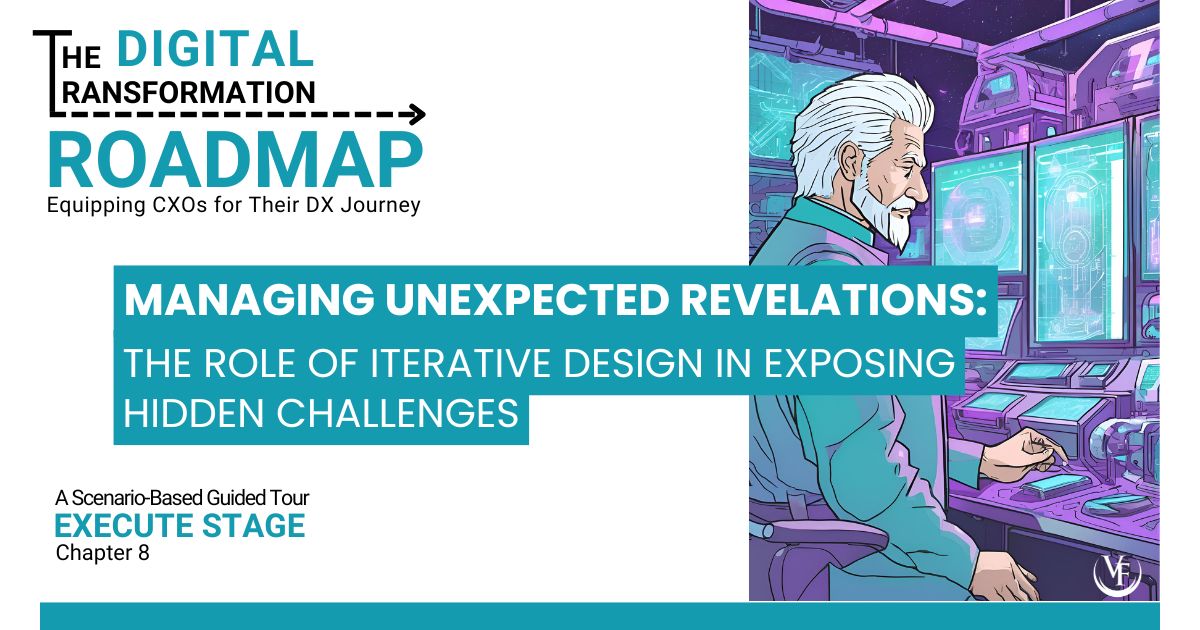
Our Execute Stage comes to life in a “scenario-based” guided tour that provides a contextual framework for DX Plan Execution. Ushering a fictional company through the process will help CXOs visualize steps in the process and identify potential challenges and opportunities on their way to plan launch.

Table of Contents:
- Chapter 1: Launching Project Pulsar: Dreams, Doubts, and Digital Transformation
- Chapter 2: Investigating Team Dynamics: Uncovering Insights for Developing an OCM Plan
- Chapter 3: Mobilizing Change Agents: A Digital Transformation’s Secret Weapon
- Chapter 4: Assessing As-Is Processes: A Critical Step in Building Requirements
- Chapter 5: Pursuing Approval for Requirements: A Battle Not Easily Won
- Chapter 6: Securing Solution Design Support From Skeptical Stakeholders
- Chapter 7: Addressing Stakeholder Misalignment and Unmet Expectations
Galactic Gravity Inc. (GGI) — a quickly growing VR headset manufacturer — has begun a large-scale digital transformation effort called ‘Project Pulsar’ to modernize their forecasting, production, and delivery solution. As part of this project, Jesse Bowman (solution architect) and Barry O’Connor (business analyst) have met with several different teams to gather requirements and propose new processes for the updated systems.
Project Pulsar uses an iterative approach to their solution design to increase their levels of user adoption, solution effectiveness, and continuous improvement within their organization. Today, Jesse and Barry will meet with the warehouse team for another round of solution design to secure sign-off on the changes they made after receiving some minor feedback.
Unfortunately, things don’t go quite as planned, and some new information from the warehouse team throws a wrench in the process. Read on to witness a common challenge with solution design sessions and why an iterative design approach is the best way to consistently deliver valuable solutions.
Watch this short video with DX Roadmap creator Camilla Richter and Victoria Fide CEO Tory Bjorklund as they dive into the significant benefits of using an iterative design approach during digital transformation efforts.
Navigating the Challenges of New Information in Iterative Design Sessions
In the brightly lit conference room, Jesse exchanged pleasantries with the members of the warehousing team in advance of their meeting. Todd, the Warehouse Manager, was new to the team, eager to prove himself, and easy to connect with. The Warehouse Associate Nicolai had been with the company since day one, but Jesse still didn’t know much about the reserved young man. Based on interactions in previous design sessions, Jesse knew that Nicolai was an extremely knowledgeable SME, however. His extensive tribal knowledge around the business processes had proven critical in documenting the as-is processes and future requirements in the initial meetings for this project.
Finally, Jesse opened his notes and kicked off the meeting by recapping what they were there to accomplish. “Let’s get started; we have a lot to cover today. We want to follow up on the outbound warehouse processes today and demonstrate how they will work in the new system. There wasn’t much feedback after the first design session so this should be fairly straightforward, but if there are any questions or concerns as we go through, don’t hesitate to interject.”
“Based on the concern you brought up last time, Todd, we’ll be focusing on the changes to the exact steps for generating the picking list and picking the materials. We’ll demonstrate how you will be able to print a physical pick list as well as view it on the scanner gun hardware.”
“Perfect,” Todd nodded, eager to see the results.
Barry then took over by covering the end-to-end process flow diagram and revisiting the “to be” process that had been discussed. Todd and Nicolai both nodded along in agreement, and Jesse was pleased that everyone seemed to be on the same page so far.
Barry then transitioned to the system, demonstrating the process step-by-step. He first presented the pick list report and its appearance within the system, followed by how it would appear on the scanner hardware’s smaller screen. Barry illustrated the completion of the pick list, either entirely through the scanner device or, in specific cases, at a terminal.
“Quick question,” Nicolai interrupted. Barry paused and nodded toward him. “What happens if we start a pick in the morning, but can’t complete it immediately and it’s not able to be completed until later in the day?”
The question stopped Barry in his tracks, and he examined the process flow diagram as if to find an answer hidden there.
Jesse cleared his throat. “I would hope that wouldn’t happen. This scenario hasn’t come up in any of the documentation from prior sessions.”
“It happens all the time,” Nicolai insisted.
Jesse refrained from asking, If it happens all the time, why didn’t you indicate that in previous design sessions?

Transformation is not easy, but it doesn’t have to be impossible. Take control of your project’s success today and schedule a free 30-minute consultation to find out how Victoria Fide can equip you for transformational success.
“We are constantly stopped from picking inventory because other people aren’t doing their jobs right,” Nicolai fumed, barely restraining his frustration. “Half the time the product isn’t even in the correct warehouse location, other times it hasn’t been processed through receiving, or the wrong quantity was received, or any number of other inefficiencies.”
“None of these scenarios were brought to our attention previously,” Barry said defensively.
“Well, we need to ensure that we can pause the picking process and come back to it later. And when this happens, we need to make sure the product is reserved so that it doesn’t get picked for another order, even if there’s a delay in picking it up. So either your solution is going to have to account for that, or other people need to be picking up the slack so we can actually finish our jobs without having to pause to fix the issues they’ve caused.”
Jesse saw a flash of frustration on Barry’s face and he jumped in before the business analyst could argue. “What I’m understanding, Nicolai, is that with the current method of generating a picking list and beginning that process, if a product isn’t where it’s supposed to be you get stuck and can’t finish the picking. And if a product isn’t picked up immediately, it might be unavailable just a few hours later because it was picked for another order. While there are some system settings that could help with this, this seems like a deeper warehousing issue that won’t be solved with new software.” He turned to Todd. “Do you have any idea what’s going on here and why there are so many inventory accuracy issues?”
Todd opened his mouth and hesitated. “I’m not entirely sure,” he confessed. “Since coming on board here I’ve been focused on getting the lay of the land and keeping things afloat.”
Jesse blinked in an effort to keep his inside thoughts from broadcasting on his face. He liked Todd, he really did, but he wasn’t being helpful at the moment.
“I’ve brought this issue up before,” Nicolai continued. “But since we’ve always just made it work, I guess there hasn’t been enough motivation to resolve it. But if the new technology isn’t able to be flexible enough for these interruptions…” his lips pressed together tightly, and he shrugged.
With Nicolai frustrated, Todd at a loss for words and Barry looking back and forth between them all, Jesse took a deep breath. “It seems we might need to adjust the way the system reserves the inventory so that it’s not dependent on the picking process, but that won’t solve the issue of not being able to get through picking without inventory problems unless there are other process changes that occur.” He looked to Todd expectantly, hoping for some support or suggestions.
The warehouse manager nodded. “I agree, we need to examine where the breakdown is happening and determine a fix before moving forward. It’s clear the scanners will not add value if our processes are undermining it. Nicolai and I will look into this further.” He turned to the young man. “I’m starting to see that I need a deeper understanding of the real-world operations on the warehouse floor to better support you. Let’s follow-up on this later this week, shall we?”
Nicolai nodded, satisfied for the moment.
Jesse told Barry to make note of the possible change in requirement so they could go back and find a potential solution for the scenario Nicolai raised.
Nobody felt particularly happy after the meeting concluded, but there was a strange catharsis, Jesse thought, after unearthing another piece of the puzzle. He was just grateful it surfaced now rather than months or even weeks later.
Two Steps Forward; One Step Back
“I can’t believe how worked up Nicolai was getting that we were unaware of this ‘obvious’ problem,” Barry commented after he and Jesse had said goodbye to the two men from the warehousing team. “They’ve already captured and approved all the requirements. Do they really want to start all over and change how they’re handling inventory reservations on the picking list?”
“It’s normal to discover new information about the process even after requirements are approved,” Jesse reminded the young business analyst. “Visualizing the process in the system jogs people’s memory in a way that simply talking through things doesn’t; that’s why we have multiple design sessions like these.”
“It just feels so inefficient!” Barry complained.
Jesse chuckled. “It’s more efficient than finding this out after we’ve already built the solution. Besides, these people aren’t experts in digital transformation; they’re experts in their roles. They’re not thinking about all of the exceptions and minutiae that may impact the whole project. It’s our job to draw those out of them.”
Barry sighed and nodded in resigned understanding. “So, what do we do now?”
“We need to go back to our notes from previous sessions and see how this new information fits into the bigger picture,” Jesse said. “Additionally, we’ll need to make sure to utilize Nicolai as much as possible; he’s critical for getting the processes dialed in, given the extent of his tribal knowledge. We’ll have to tailor our approach to make sure and keep channels of communication open with him and give him the support he needs so we can get the details we need.”
“Let’s hope it goes better than this meeting,” Barry muttered.
Jesse was inclined to agree.

Conclusion and Next Steps
When new information surfaces during a design session, it can feel frustrating and like a step in the wrong direction. However, the nature of iterative design allows for these unexpected developments to take place without derailing the entire project. It is the SA and BA’s job to draw out the information needed to build a solution that benefits the entire company.
Identifying and addressing unforeseen challenges during the design phase is vital to the success of any project. As demonstrated, effective communication and collaboration can transform potential setbacks into valuable opportunities for improvement. By remaining agile, engaging stakeholders like Nicolai, and carefully revisiting requirements, teams can ensure a cohesive and comprehensive solution that aligns with business objectives.
Check out our article on using iterative design to achieve success, and subscribe to our newsletter for more insights and tips on successful digital transformation through scenario-based articles.
Subscribe to our weekly LinkedIn Digital Transformation Success newsletter and get notified of each new edition.
